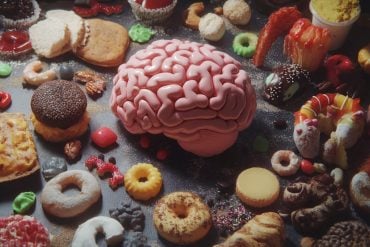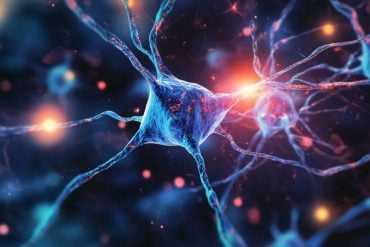Summary: Cannabidiol (CBD) simultaneously acts on two targets in pain-sensing neurons. Researchers are developing new drugs that have similar actions to CBD that may be better absorbed by the body.
Source: Harvard
In recent years, cannabidiol, a compound derived from cannabis plants, has begun popping up more and more in everyday life.
Now legal in most U.S. states, the cannabinoid commonly known as CBD can be found in supermarkets and drugstores, where it is often sold as a gummy, an oil, or a cream, and is praised by some for its pain-suppressing properties.
But does CBD actually relieve pain? If so, how precisely does it do so? And what would it take to harness the beneficial properties of CBD into a safe and effective pain medicine?
These are some of the questions that Bruce Bean, the Robert Winthrop Professor of Neurobiology in the Blavatnik Institute at Harvard Medical School, and Clifford Woolf, HMS professor of neurology at Boston Children’s Hospital, have teamed up to explore.
Their research so far, conducted in animal models and cells, suggests that CBD simultaneously acts on two targets in pain-sensing neurons. They are now using this information to develop drugs that work the same way as CBD and are similarly safe and nonaddictive, but are more effectively absorbed by the body
Untreated pain is a significant and widespread health issue that can interfere with daily activities, lead to poor mental health, and generally result in a reduced quality of life for those afflicted. The U.S. Centers for Disease Control and Prevention estimates that around 20.4 percent of U.S. adults, or 50 million people, suffer from chronic pain, defined as pain lasting longer than three to six months.
An earlier study suggests that the economic toll of chronic pain in the United States is between $560 and $635 billion per year. However, some of the currently available and commonly prescribed pain medicines have tremendous addictive potential, leaving those who use them vulnerable to becoming dependent.
“Something that would relieve pain that’s not addictive is a great unmet need, and remains one of the most formidable challenges in modern medicine,” Bean said.
A convergence of research
Bean and Woolf have long shared an interest in developing better pain medicines. Currently, effective treatments for pain are somewhat limited, Woolf said, and opioid-based drugs prescribed for pain carry a significant risk of addiction, contributing in part to the widespread opioid crisis.
In fact, the CDC estimates that since 1999, more than 932,000 people have died from drug overdoses, and in 2021, opioids were involved in 75.1 percent of overdose deaths, claiming 80,816 lives.
Prescription opioids, while not directly involved in most overdose deaths, often serve as a gateway to more dangerous synthetic opioids such as fentanyl. Yet progress in developing new pain treatments has been slow, in large part because such drugs must precision-target only pain pathways while sparing other parts of the nervous system.
“Both of us are very interested in conditions for which there’s no effective treatment, and pain certainly happens to be that,” Woolf said.
“We are trying to see if we can make a big impact on patients by coming up with novel classes of highly effective and safe analgesics.”
However, the researchers did not initially plan to work together on CBD.
Bean conducts basic research on the mechanisms underlying electrical signaling in the brain. Specifically, he studies tiny channels in the membranes of neurons that open and close to control the flow of ions, which in turn determines whether neurons fire and transmit electrical messages.
Woolf’s work centers on discovering new drugs to treat pain and neurodegenerative diseases. He specializes in performing large-scale screens on human neurons to identify novel drug targets, as well as compounds that modify disease course. In particular, he focuses on membrane receptors and ion channels that mediate inflammation and pain.
In the course of his research, Bean became intrigued by experiments suggesting that CBD reduces pain-related behavior in mice and rats, as well as anecdotal reports of CBD as a painkiller in humans.
“There are no good clinical studies of CBD for pain, but a lot of people say that it helps them with their pain,” Bean said. “We started looking at CBD directly on the electrical activity of neurons to see what it did and how it did it.”
Working in mouse models, Bean and his team found that CBD inhibits two different kinds of sodium channels found in the membranes of nociceptors, the specialized neurons that sense and communicate pain.
This inhibition prevents sodium from rushing inside nociceptors, which keeps the neurons in an inactive state and stops them from firing and transmitting a “pain” message via an electrical signal.
Meanwhile, Woolf and his lab had conducted a screen on thousands of bioactive compounds to see if any of them interacted with a particular potassium channel found in the membranes of nociceptors and is involved in suppressing pain signaling—and unexpectedly, they hit on CBD.
Together, Woolf and Bean figured out that CBD activates the potassium channel, allowing potassium ions to flow inside nociceptors. This influx of potassium reduces the firing activity of the neurons, thus blocking pain signaling. In fact, flupirtine, a pain medicine with restricted use due to liver toxicity, works by the same mechanism.
“We realized that CBD is really interesting because it actually acts on two different targets in pain sensing neurons,” Bean said.
The dual finding for CBD is especially exciting, Woolf added, because sodium channels and potassium channels work together to modulate the activity of nociceptors, yet there are no treatments that target both.
“There was nothing in the literature about it, but out it popped that CBD had this potassium channel-opening activity in addition to sodium channel-blocking activity,” Woolf said. “That’s exactly what we want if we want to control the excitability of this set of neurons.”
The future of CBD
CBD has several advantages as the possible basis of an eventual pain medicine. Most significantly, it does not seem to be addictive, and it appears to be relatively safe in humans, with few side effects. In fact, it is already approved by the FDA for use in children with severe, drug-resistant epilepsy.
Still, CBD is far from ready for prime time. As an herbal compound derived from cannabis plants, it is highly variable from batch to batch and may contain other ingredients with undesirable effects. Children with epilepsy take CBD orally, mixed with sesame oil, and because CBD is poorly absorbed by the body in this form, they must consume large quantities of it.
Gaps remain in understanding the safety of CBD, including how it affects various organ systems as well as how it interacts with other drugs.
“CBD has features that we want, but it doesn’t have exactly what we want, so we have to work to improve it,” Woolf said.
“We’re trying to take this herbal compound with a profile that we think is promising and make it even better and more reliable.”
“Although CBD is very effective in blocking the activity of pain-sensing neurons when applied directly to a neuron in a dish, we have no idea what concentration ultimately reaches nerve cells in the body, and the concentration is probably very low with oral administration,” Bean added, so it is unlikely that CBD itself will be useful as a painkiller.
“We want to make new compounds that retain the properties and the activity that we found in CBD, but are more effective drugs.”
It is also essential, he said, that any new compounds don’t act on CB1, the receptor that binds THC to give marijuana its psychoactive effects.
Importantly, the researchers noted, any CBD-based medicines would need to be rigorously tested and approved by the FDA to ensure both safety and efficacy.

Bean and Woolf are taking a two-pronged approach to their work. One avenue involves starting with the CBD molecule itself and trying to create derivatives based on that initial scaffold that improve the properties of the compound.
They are also planning to use large-scale screens to identify new compounds with completely different chemistry that target the same sodium and potassium channels in pain-sensing neurons targeted by CBD.
The researchers emphasized that CBD is part of their broader push to change how drugs, including painkillers, are developed. In traditional drug development, Woolf said, researchers choose a single target and find compounds that act on that target.
However, this approach has had limited success in translating results from the lab to the clinic: when compounds move into clinical trials, they often turn out to have low efficacy or unexpected side effects.
“We’re trying to identify new ways of developing therapeutics and we’ve recognized that an alternative strategy is a polypharmacological one,” Woolf said. “The idea is that multiple targets will give us greater selectivity and safety than compounds that only act on one target.”
This strategy is bolstered by growing evidence that different types of neurons in the body have different combinations of ion channels—knowledge that the researchers are trying to exploit to develop more targeted drugs with fewer side effects. CBD, for example, targets a combination of sodium and potassium channels that seems to be specific to nociceptors, which may reduce the compound’s off-target effects.
And while their research on CBD is largely a work in progress, the researchers are hopeful that they will eventually succeed in developing a drug based on CBD that is safe, effective, and easy to take—and in the process, accomplish their overarching goal of building a better pain medicine.
About this pain and neuropharmacology research news
Author: Press Office
Source: Harvard
Contact: Press Office – Harvard
Image: The image is in the public domain
Original Research: Open access.
“Cannabidiol activates neuronal Kv7 channels” by Han-Xiong Bear Zhang et al. eLife
Abstract
Cannabidiol activates neuronal Kv7 channels
Cannabidiol (CBD), a chemical found in the Cannabis sativa plant, is a clinically effective antiepileptic drug whose mechanism of action is unknown. Using a fluorescence-based thallium flux assay, we performed a large-scale screen and found enhancement of flux through heterologously expressed human Kv7.2/7.3 channels by CBD.
Patch-clamp recordings showed that CBD acts at submicromolar concentrations to shift the voltage dependence of Kv7.2/7.3 channels in the hyperpolarizing direction, producing a dramatic enhancement of current at voltages near –50 mV. CBD enhanced native M-current in mouse superior cervical ganglion starting at concentrations of 30 nM and also enhanced M-current in rat hippocampal neurons.
The potent enhancement of Kv2/7.3 channels by CBD may contribute to its effectiveness as an antiepileptic drug by reducing neuronal hyperexcitability.







